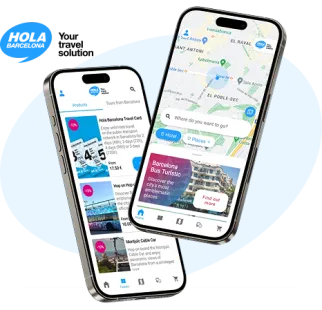Avinguda Diagonal
The backbone of Ildefons Cerdà’s new Barcelona
Avinguda Diagonal has evolved alongside the transformation of the city, eventually crossing it from end to end. Since the initial urbanization of its central section, Diagonal has been progressively extended in line with Barcelona’s changes and is today a major avenue that structures the entire city.

Barcelona Bus Turístic, on the Hola Barcelona app
Your app for visiting the city with the Barcelona Bus Turístic: routes, stops and the most iconic places. A comfortable way to carry your tickets too!
The history of Diagonal
The history of Diagonal reflects the growth of a city that has in this avenue a true backbone connecting very different neighborhoods.
Avinguda Diagonal is one of the main arteries that Ildefons Cerdà envisioned for the new Eixample of Barcelona. Over its nearly 11 kilometers, it crosses the city from southwest to northeast and intersects other major roads such as Passeig de Gràcia, Passeig Sant Joan, and Gran Via de les Corts Catalanes.
When construction began in 1884, Avinguda Diagonal only connected Pau Claris Street with Passeig de Gràcia. Its lengthy urbanization process has mirrored Barcelona’s transformations and, at the same time, has witnessed the city’s evolution.
During its early decades, renowned architects such as Puig i Cadafalch designed works like the Casa de les Punxes, Can Serra at the junction with Rambla Catalunya, or the Palau Baró de Quadras, which changed its main entrance from Rosselló Street to Avinguda Diagonal, which was beginning to emerge as a key axis of the new Barcelona. From this early period also come the Casa Pérez-Samanillo and Casa Sayrach.
Around 1920, on the Besòs side, some interesting buildings had been planned, such as Casa Planells by Josep Maria Jujol, while on the other end, Diagonal already reached Les Corts, near Turó Park. But the next major boost came with the construction of the Palau Reial, when architect Francesc de Paula Nebot took the opportunity to extend Diagonal and change its appearance from Plaça Francesc Macià onward. From this point, Avinguda Diagonal widened to 84 meters up to Entença Street and 92 meters up to Plaça Maria Cristina. However, the final stretch, corresponding to the new University Zone, was not built until the 1950s.
At the other end of the avenue, major growth occurred thanks to the Olympic boost, which turned Plaça de les Glòries into a new central area of the city. With the approval of the 22@ Plan to transform the Poblenou neighborhood and later the creation of the Parc del Fòrum, Diagonal was extended almost to the sea.
How to get to Diagonal?
You can stroll along Diagonal using either the Blue Route or the Red Route of the Barcelona Bus Turístic, getting off at the Diagonal - Francesc Macià stop or the Passeig de Gràcia – La Pedrera stop.
For the curious
- Diagonal is the only street in Barcelona numbered from north to south.
- Diagonal can be cycled from end to end. It’s one of the most pleasant rides in the city, as it’s fully marked with a bike lane.










